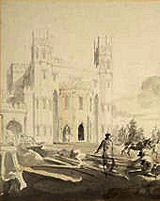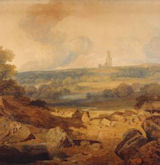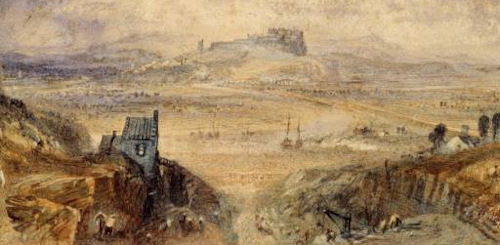




It is a truth universally acknowledged, that a single picture is worth a thousand words.
And yet consider Chapter One of Pride and Prejudice, the Novel:— several scraps of information, a few lines of dialogue, significantly fewer than a thousand words, and we understand perfectly:—
Chapter Two is like unto the first, but even shorter. At its end we have learned how they are addressed by their parents and what to expect from each of the daughters:— beauty and amiability from Jane, quick wit from Elizabeth, assumed intellectuality on the part of Mary, fretfulness from Kitty and a robust confidence in herself by Lydia, the youngest.
* * * * *
We have also been made aware of the peculiar manner in which Mr. Bennet chooses to carry out his wife's wishes:— by first vigorously denying any intention of complying, then teasing the entire family with ambiguous hints and cryptic utterances until the time has come to announce the portentous news to his astounded female relatives that the deed has been indeed completed.
But most of all we know that we are in the presence of a literary genius, blessed with great wisdom, biting wit and shrewd insight wrapped in an uncommonly pleasurable economy of expression. And all from the pen of an inexperienced girl in her early twenties. Her clergyman father is said to have submitted the manuscript to a publisher friend who rejected it unread, the manuscript only being accepted for publication many years later along with a later novel. This seems shockingly cavalier treatment of a work of such towering mastery of the English language that it remains an enduring favourite two centuries later. Only upon subsequent reflection do we stop to contemplate the wonder is not that the manuscript was first rejected, but that it was ever accepted. In more senses than one the Novel must have been deeply troubling to contemporary publishers. — Even today the contempt shown her mother by the Novel's heroine is quite shattering to a sensitive mind.
I buy books so that I can read them over and over; my husband so that he needn't read them at all, or, rather, so that they will be to hand when he wants them. We each brought hundreds of books into our marriage; — the only duplicate was Jane Austen's Pride and Prejudice. If the Novel were merely a study of manners, of outdated customs, it would have been supplanted in public esteem decades ago. In fact, in writing Pride and Prejudice, Jane Austen has constructed a literary mansion of superlative strength and durability.
Like all great architecture, each layer forms a perfect foundation for the layer to be placed above. For example, the first two chapters are devoted exclusively to the members of the Bennet family. Mrs. Bennet, Mr. Bennet; Jane and Elizabeth; the three younger daughters, form the perfect subterranean base — a cornerstone — not merely for the layer which is to come, but for the entire eventual building.
There are to be no last-minute additions to the structure — no wings projecting erratically toward the unforeseen — no sudden plot-induced coincidences — nothing not limited in breadth and scope by this most meticulously planned and sturdily built of literary sub-foundations.
The next ten chapters (of a total of 61!) combine to form the foundation proper.
It is a truth universally acknowledged, that a single man in possession of a good fortune must be in want of a wife.
However little known the feelings or views of such a man may be on his first entering a neighbourhood, this truth is so well fixed in the minds of the surrounding families, that he is considered as the rightful property of some one or other of their daughters.
The creators of the 1980 BBC miniseries devised a simple yet radical method of including these sparkling lines in the opening scenes of their film: by assigning the first as dialogue to Elizabeth, thereby establishing her characteristic intelligence and wit — and the second as the rather sedate reply of the older and more sober Charlotte Lucas.
Assigning the Novel's second paragraph to be recited by Charlotte necessitated bringing her into the Bennet household in the opening scenes of the miniseries. For reasons unknown to me, this addition of an outsider seems to increase rather than detract from the Bennet family as centre of gravity. — And Elizabeth's established friendship with Charlotte accounts of course for her presence at Rosings when Mr. Darcy arrives for his usual visit to Lady Catherine de Bourgh, his maternal aunt.
If the Bennet family is the cornerstone, then Charlotte Lucas, Mr. Collins, Mr. Wickham, and in particular the girls' Aunt and Uncle Gardiner, are to be columns, or pillars supporting the main structure. Even Lady Catherine de Bourgh, greatly against her will, is to be made use of in this mischievous manner.
In the previous webpage (Fear and Loathing:— The Filming of a Beloved Novel), I gave my opinion at some length on the beginnings of 1940 film and 1995 miniseries, and won't torment the viewer with unnecessary repetition.
Need it be mentioned that words like cornerstone, pillar, and even foundation in these webpages are used in their figurative meaning?
My dictionary [Webster's New Collegiate Sixth Edition] assures me that I can safely use the word cornerstone in a literary sense to describe Chapters One and Two of Jane Austen's Novel [2. Hence, something of fundamental importance]. When it comes to architecture, however, cornerstone is more apt to be used of 1. ... a stone laid at the formal inauguration of the erection of a building, which doesn't begin to meet requirements.
According to the Glossary of Sir Banister Fletcher's majestic A History of Architecture, Sixteenth Edition, which has had the misfortune to fall into my unworthy hands, I'm forced to use not cornerstone but base [Page 966 Base (Gk. basis = That on which one stands). The lower portion of any structure or architectural feature] if I don't wish to do injury to Architecture, the mother of all arts [Page 4].
And Webster's definition of base is in full agreement:— 1. The bottom of anything, considered as its support; foundation. 2. The fundamental part of a thing; groundwork.
And too bad if base in common usage means low, vile, opposed to noble.
* * * * *
Pictures 3A
With the exception of Photos from film promotions in webpage
Introduction 3A, and the Hubble Footer,
most Pictures on these Pride and Prejudice and other
Austen webpages, are from the
Turner Bequest of the Tate Museum
Collection Online.
This Page Chapters 1 and 2,
The Bennet Family, Cornerstone of the Novel:
 Artist: Unknown, British School 18th century (1700-1799)
Artist: Unknown, British School 18th century (1700-1799)
Title: A Sandpit, Date not known
Medium: Graphite and watercolour on paper
Dimensions: Support 158 x 231 mm
Acquisition Purchased as part of the Oppé Collection with assistance from
the National Lottery through the Heritage Lottery Fund 1996
Reference: T10255
View this artwork by appointment, at Tate Britain's Prints and Drawings Rooms
 JMW Turner, circa 1799
JMW Turner, circa 1799
Title: Builders Working
on the Construction of Fonthill,
circa 1799
Dimensions: Support 250 x 405 mm
Private Collection, Turner Worldwide, Reference: TW 1565
 JMW Turner, exhibited 1800
JMW Turner, exhibited 1800
Title: East View of the Gothic Abbey (Noon) Now Building at Fonthill, the Seat of W. Beckford, Esq.
Medium: Watercolour on paper;
Dimensions: Support 685 x 1035 mm
Collection: The National Gallery of Scotland, Turner Worldwide, Reference TW0163, Wilton 338
The
National Gallery of Scotland, Website Wikipedia
 JMW Turner, circa 1833
JMW Turner, circa 1833
Title: Stirling [View of Stirling Castle from Quarry]
Medium: Watercolour on paper;
Dimensions: Support 89 x 165 mm
Collection: Glasgow Museums, Turner Worldwide, Reference TW0287, Wilton 1122,
Glasgow Museum,
Website Glasgow Life
________________________